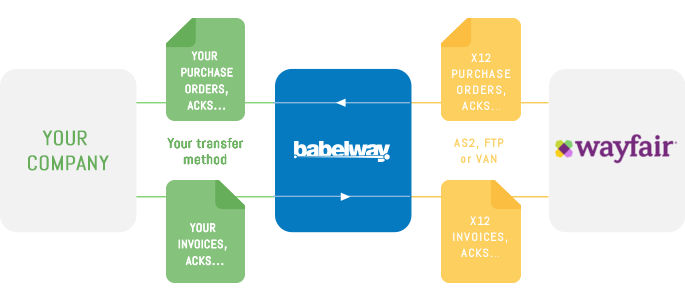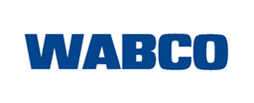
Babelway is an intuitive web-based platform that allows business partners to directly integrate any two IT systems.
- All major connectors and document types
- Full control of your setup and visibility into your connections
- Enterprise-level security and compliance guarantees
- Support from EDI specialists with 10+ years’ experience
Get your first Wayfair connection for free
We will contact you after setting up a free trial environment for your first Wayfair integration:
No strings attached; stop when you want.
Your credentials will only be used to create a trial Babelway account and contact you to present the initial setup and next steps.

Wayfair supports VAN, FTP, AS2, X12, CSV, EDIFACT…
We can handle them all. So whatever Wayfair requires from you, we can make it happen.
How do we achieve this?
Wayfair EDI involves
- Standard X12 documents
- 810 Invoice
- 850 Purchase Order
- 855 Purchase Order Acknowledgement
- 856 Ship Notice
- 869 Order Status Inquiry (recommended but optional)
- 870 Order Status Report (recommended but optional)
- 997 Functional Acknowledgement
- AS2, FTP (Wayfair preferred) or VAN (Wayfair discouraged) transfer protocols.
- Additionally, Wayfair will require you to push your inventory data either using 846 Inventory Inquiry/Advice or using a flat file CSV document.
Because Babelway fully supports all these technologies, you will be able to implement any integration flow with Wayfair using Babelway.
The challenges of online retail EDI
Wayfair only works with drop shipping. Although you will still be using traditional EDI, there are some differences when using EDI for drop shipping integrations as opposed to when using it to supply stock for brick and mortar retailers.
Aisles are only so wide and high. They can get very big but they will never compete with endless online catalog pages. It can be difficult to get noticed in such a vast offering. Thus, if diversifying your retailers is a best practice with brick and mortar stores, it’s a basic survival need when working with online retailers. Chances are, you won’t be integrating with a single retailer; you will quickly want to connect to as many as you possibly can. This means today’s integration challenge with Wayfair is likely to preceed another with Lowes.com, Home Depot, Michaels etc. All of which are sure to use slightly different technologies and EDI specifications.
You will want an extremely flexible and reliable EDI solution.
Of course, EDI was always about getting partners to trade more effectively. However, online retailers bring this to a whole new level, especially when working with drop shipping.
When you’re preparing black Friday with brick and mortar stores, you’ve been exchanging orders for weeks and filling distribution centers and warehouses with your stocks for quite some time before the big day comes and hopefully brings in that boost in profits we all await at that point of the year.
When drop shipping through online retailers, this part is trickier. You can prepare all you want on your end, come black Friday, you have to hope that your impeccable data integration can handle the back and forth of orders, invoices, and inventory advices that will keep your business running through the busy day.
You now have a single point of failure which can make or break the day.
Online retail, unlike its brick and mortar counterpart, doesn’t come with a history of paper data interchange before they moved on to the electronic version. As a consequence, EDI is unavoidable. You won’t run into online web EDI alternatives or paper workarounds because they were never in the picture in the first place.
You can only rely on your EDI.
With a single daily (perhaps even weekly) order and invoice, your EDI integration with many offline retailers is covered. If you’re going for the drop shipping model however (which is how Wayfair operates), it’s likely you’re going to need much greater real-time data integration. Ever wondered how websites could provide information such as: “only 10 items left”, “product available from this date”, “order is being packaged”, “notify me when this product is available” etc. for stocks they don’t manage? This user experience is made possible through the extremely tight integration between an online retailer and its suppliers. This can mean exposing a lot of your inventory data multiple times a day through less common EDI messages in the brick and mortar world.
This all amounts to more messages and tighter electronic data integration.


